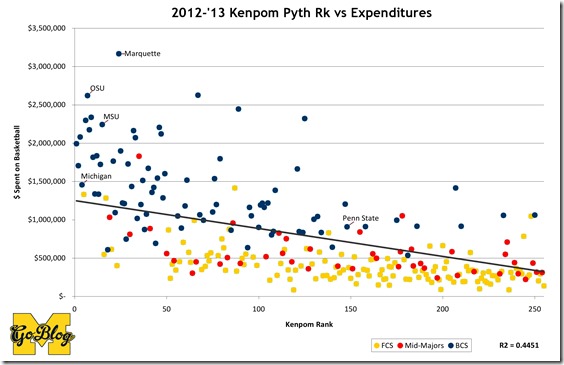Hokepoints Counts de Mone


'de-moh-NAY!' s'il vous plait.
The NCAA has published its 2013 data submitted by member institutions for the purposes of Title IX compliance. You can download the spreadsheets from ope.ed.gov.
Politics refresher: Title IX is a gray area topic since it is political but affects college sports which this blog is about. This is a feel thing: it is logical to point out that a male wrestler's experience will be more similar to that of any female basketball player than Derrick Walton's, it is politics to label that "reverse discrimination."
Quinze, seize you: Generally BCS teams spent between 37% (Stanford) and 77% (Oklahoma State) less on the women's sports than the men's. Michigan spent about $7.00 on the fellas for every $3.00 on the gals, a ratio near the top. BCS schools, private schools (who didn't used to have to comply) and Southern schools tended to higher disparities; among the 15 lowest women-to-men expenditure ratios all but three (Minnesota, ND and Pitt) were in the Confederacy. The Dept. of Education doesn't regulate an annual expenditure ratio between men's and women's sports, but they look at them as part of the nebulous compliance system.
| Avg Expenditures by Conference (in millions) 2012-13 | |||
|---|---|---|---|
| Conf | Men | Women | Ratio |
| WAC | $4.8 | $3.7 | 78% |
| Big East | $11.3 | $7.0 | 62% |
| MAC | $11.3 | $6.0 | 53% |
| MtnWest | $13.7 | $6.7 | 49% |
| Sun Belt | $8.5 | $4.0 | 48% |
| Conf USA | $12.6 | $5.8 | 46% |
| Big Ten | $38.8 | $16.7 | 43% |
| Pac 12 | $32.0 | $13.7 | 43% |
| American | $25.0 | $10.0 | 40% |
| Big XII | $33.0 | $13.1 | 39% |
| SEC | $39.5 | $14.7 | 37% |
| ACC | $34.6 | $12.5 | 36% |
Building Lies. Weirdly, expenses appear more normal than the revenues, which get downright weird. A few examples (for reference, Michigan's men's hockey team reported revenues of $3.2 million, the 4th-most in that sport):
- Stanford's women's basketball team, which was a 1 seed that lost in the Elite 8, reported $16.5 million. The next-highest is Baylor's ($5.9 million), Vandy ($5.6 M), Tennessee ($4.9 M) and UConn ($4.7M)
- Clemson's women's diving reported revenues of $406k. Only two other schools reported any revenue for that.
- TCU said they made $3.4 million from horseback riding and $416k from women's rifling.
- Southern's women's soccer team, which didn't make the tournament field, reported $3.1 million in revenue, which is more than their football team and almost as much as all of their men's sports combined.
- Robert Morris's women's hockey team reported more revenue ($1.1 M) than its men's team ($997k).
- Michigan's men's lacrosse team led the country in revenue: $2.4 million
- Wisconsin's women's ice hockey reported $7.6 million; their men's team reported just under $12 million (double what next-highest, Minnesota, made).

Michigan's the rare school that doesn't pretend its opulent escalator entrance was built for the women's gymnastics team. [MGoBlue.com]
Wisconsin's hockey numbers might be a clue as to how these schools are getting their numbers. The Badgers recently built a practice facility adjacent to the the Kohl Center with donated funds; the women's team plays their game there. Stanford got a massive donation' last year from its version of Ross and built a multi-sport athletic facility with his name on it. Michigan appears to have funneled some of their Big House improvement through lacrosse.
It appears what's happening is when a donation is put toward a building project the schools tend to split that between whichever teams use it. End result: teams that funded major construction projects ended up with the highest ratios of $$ spent on women versus men.
Biggest liars? There's no way to figure out the accounting for these things but it's obvious some programs play with the books more than others. TCU is pretending they built a $3.4 million storage shed for saddles and bridles that the football team just happens to use as an indoor practice facility. They also upgraded the ROTC rifling range, which they attributed to the women's team. They're a private school that to be a women's college and is still 57% female [ED-S: apologies—you have no idea how many people I've repeated that factoid to over the years] that spent the last decade trying to become a BCS program, which explains the fiscal acrobatics.
[After the jump, comparing expenses to recruiting and performance]
Quick expense report. Because of my unhealthy relationship with vlookup functions, between various spreadsheets I've created over the years I now have a pretty extensive list of what various universities call themselves in various inputs (NCAA stats, recruiting databases, Kenpom, etc). So I figured I'd to combine them and compare the Title IX data with, you know, stuff but ran out of time. Here's how basketball expenditures last year compared with performance (kenpom pyth rank):
And here's how football and basketball recruiting corresponded to the money each school admitted spending on that. I just added the 247 football and basketball scores together, which makes the data lean heavily toward football, but that's how it should be since you typically recruit 5x as many football players per year:
| Avg Recruiting Expense for All Men's Teams | |
|---|---|
| Conf | $ Spent |
| SEC | $1,148,626 |
| Big Ten | $1,037,491 |
| Big XII | $948,361 |
| ACC | $848,718 |
| Pac 12 | $805,193 |
| BCS Avg | $958,847 |
| Mid-majors | $326,989 |
| FCS | $168,034 |
I forgot to add Illinois to the labeling; they're that solitary light blue dot that spent the same as ND or OSU or Bama and came up 66th in combined football/hoops recruiting. Lollillinois.
Let's table that by conference:
The SEC sits atop more football talent than anybody else, but also outspends everybody else in recruiting. But not by all that much: a hundred thousand. That can mostly be put at two outliers: Auburn and Tennessee. There was certainly a correlation between good recruiting classes and expenditures on recruiting, but it was one mostly based on what conference you're in. Teams of a level mostly spent what they had to spend. Indiana isn't on a monstrously different playing field from Alabama, but there's a pretty strong delineation between the mid-major conferences in football and the BCS ones, especially since Louisville becomes a BCS team next year.
February 18th, 2014 at 11:10 AM ^
I wonder if all the regulation and rules applied to college sports today create more problems. Maybe an open system in the revenue sports (football) where players are paid as professionals with "salary" caps and a draft system would actually be a fairer system. It would simply do away with all this other nonsense where schools play games just to get an edge and try to appear to comply with these increasingly complex rules.
February 18th, 2014 at 11:57 AM ^
February 18th, 2014 at 11:19 AM ^
Assuming this is accurate and not made-up or an exaggeration, how is this legal?
TCU is pretending they built a $3.4 million storage shed for saddles and bridles that the football team just happens to use as an indoor practice facility.
Is it just that there is no one who cares? That these are all regulations that exist, that just simply aren't enforced by anyone? Because if it's the case that the school said they spent millions of dollars on something to comply with federal regulations, but really built something totally different, that seems like fraud.
February 18th, 2014 at 11:21 AM ^
A title that requires knowing both the correct pronunciation of Bryan Mone's name and quotes from History of the World: Part 1--how delightful. What percentage of this blog's readership falls into both of those categories? I think it's probably really high...
February 18th, 2014 at 1:53 PM ^
It's good to be the king
February 18th, 2014 at 11:26 AM ^
I would like to know what an unhealthy relationship with vlookup manifests as. Does your computer shock you with a thousand volts if your column isnt in alphabetical order?
February 18th, 2014 at 6:45 PM ^
February 18th, 2014 at 8:32 PM ^
I use it more than gloom up these days.
February 18th, 2014 at 8:33 PM ^
February 18th, 2014 at 11:27 AM ^
I'm unfamiliar with programming and web design, so this might be a stupid request, but could you guys put the Kenpom vs. Expenditures graph up as an interactive? It's neat as-is but I'd love to see who the sad, sad BCS outliers are, and the FCS and mid-majors who spend just a bit but are in the top 50.
If it's too hard or expensive or something weird, no worries. Just curious.
February 18th, 2014 at 11:27 AM ^
+1 for the reference...
The people are revolting!
February 18th, 2014 at 12:35 PM ^
February 18th, 2014 at 11:40 AM ^
No way.
February 18th, 2014 at 12:06 PM ^
Interesting. According to Wikipedia, it was not only always co-ed, it was actually one of the first co-ed institutions in the west.
February 18th, 2014 at 12:21 PM ^
February 18th, 2014 at 12:09 PM ^
Look up the 1st Minnesota regiment at the Battle of Gettysburg. Confederacy, my ass.
/iknowyourejokin
February 18th, 2014 at 12:10 PM ^
CoEd school of higher learning in Texas and it was first established as the AddRan Male & Female College in 1873.
February 18th, 2014 at 3:45 PM ^
Mone is going to be Money for us in the future ;)
February 18th, 2014 at 3:53 PM ^
February 18th, 2014 at 8:55 PM ^
The number is an apportionment from that big donation.


Comments